Aye-aye
The aye-aye (Daubentonia madagascariensis) is a long-fingered lemur, a strepsirrhine primate native to Madagascar with rodent-like teeth that perpetually grow[4] and a special thin middle finger.
| Aye-aye | |
|---|---|
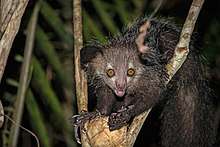 | |
| Scientific classification | |
| Kingdom: | Animalia |
| Phylum: | Chordata |
| Class: | Mammalia |
| Order: | Primates |
| Suborder: | Strepsirrhini |
| Superfamily: | Lemuroidea |
| Family: | Daubentoniidae Gray, 1863[3] |
| Genus: | Daubentonia É. Geoffroy, 1795 |
| Species: | D. madagascariensis |
| Binomial name | |
| Daubentonia madagascariensis Gmelin, 1788 | |
| Species | |
| |
 | |
| D. madagascariensis distribution[1] | |
| Synonyms | |
|
Family:
Genus:
Species:
| |
It is the world's largest nocturnal[5] primate. It is characterized by its unusual method of finding food: it taps on trees to find grubs, then gnaws holes in the wood using its forward-slanting incisors to create a small hole in which it inserts its narrow middle finger to pull the grubs out. This foraging method is called percussive foraging, and takes up 5–41% of foraging time.[6][7] The only other animal species known to find food in this way is the striped possum.[8] From an ecological point of view, the aye-aye fills the niche of a woodpecker, as it is capable of penetrating wood to extract the invertebrates within.[9][10]
The aye-aye is the only extant member of the genus Daubentonia and family Daubentoniidae. It is currently classified as Endangered by the IUCN; and a second species, Daubentonia robusta, appears to have become extinct at some point within the last 1000 years.[11]
Etymology
The genus Daubentonia was named after the French naturalist Louis-Jean-Marie Daubenton by his student, Étienne Geoffroy Saint-Hilaire, in 1795. Initially, Geoffroy considered using the Greek name Scolecophagus ("worm-eater") in reference to its eating habits, but he decided against it because he was uncertain about the aye-aye's habits and whether other related species might eventually be discovered.[12] In 1863, British zoologist John Edward Gray coined the family name Daubentoniidae.[13]
The French naturalist Pierre Sonnerat was the first to use the vernacular name "aye-aye" in 1782 when he described and illustrated the lemur, though it was also called the "long-fingered lemur" by English zoologist George Shaw in 1800—a name that did not stick. According to Sonnerat, the name "aye-aye" was a "cri d'exclamation & d'étonnement" (cry of exclamation and astonishment). However, American paleoanthropologist Ian Tattersall noted in 1982 that the name resembles the Malagasy name "hai hai" or "hay hay", which refers to the animal and is used around the island. According to Dunkel et al. (2012), the widespread use of the Malagasy name indicates that the name could not have come from Sonnerat. Another hypothesis proposed by Simons and Meyers (2001) is that it derives from "heh heh", which is Malagasy for "I don't know". If correct, then the name might have originated from Malagasy people saying "heh heh" to avoid saying the name of a feared, magical animal.[12]
Evolutionary history and taxonomy
Due to its derived morphological features, the classification of the aye-aye was debated following its discovery. The possession of continually growing incisors (front teeth) parallels those of rodents, leading early naturalists to mistakenly classify the aye-aye within the mammalian order Rodentia[14] and as a squirrel, due to its toes, hair coloring, and tail. However, the aye-aye is also similar to felines in its head shape, eyes, ears and nostrils.[15]
The aye-aye's classification with the order Primates has been just as uncertain. It has been considered a highly derived member of the family Indridae, a basal branch of the strepsirrhine suborder, and of indeterminate relation to all living primates.[16] In 1931, Anthony and Coupin classified the aye-aye under infraorder Chiromyiformes, a sister group to the other strepsirrhines. Colin Groves upheld this classification in 2005 because he was not entirely convinced the aye-aye formed a clade with the rest of the Malagasy lemurs.[17]
However, molecular results have consistently placed Daubentonia as the most basal of lemurs.[18][19][20][21][22][23][24][25] The most parsimonious explanation for this is that all lemurs are derived from a single ancestor that rafted from Africa to Madagascar during the Paleogene.[21][26][27] Similarities in dentition between aye-ayes and several African primate fossils (Plesiopithecus and Propotto) have led to the alternate theory that the ancestors of aye-ayes colonized Madagascar separately from other lemurs.[28] In 2008, Russell Mittermeier, Colin Groves, and others ignored addressing higher-level taxonomy by defining lemurs as monophyletic and containing five living families, including Daubentoniidae.[29]
Further evidence indicating that the aye-aye belongs in the superfamily Lemuroidea can be inferred from the presence of petrosal bullae encasing the ossicles of the ear.[14] The aye-ayes are also similar to lemurs in their shorter back legs.[15]
Anatomy and morphology
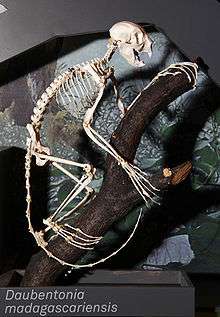
A full-grown aye-aye is typically about three feet long with a tail longer than its body. The species has an average head and body length of 14–17 inches (36–43 cm) plus a tail of 22–24 inches (56–61 cm), and weighs around 4 pounds (1.8 kg).[30]
Young aye-ayes typically are silver colored on their front and have a stripe down their back. However, as the aye-ayes begin to reach maturity, their bodies will be completely covered in thick fur and are typically not one solid color. On the head and back, the ends of the hair are typically tipped with white while the rest of the body will ordinarily be a yellow and/or brown color.
Among the aye-aye's signature traits are its fingers.[25] The third finger, which is thinner than the others, is used for tapping, while the fourth finger, the longest, is used for pulling bugs out of trees, using the hooked nail.[15] The middle finger is unique in that it possesses a ball-and-socket metacarpophalangeal joint.[31] The aye-aye has also evolved a sixth digit, a pseudothumb, to aid in gripping.[32]
The complex geometry of ridges on the inner surface of aye-aye ears helps to sharply focus not only echolocation signals from the tapping of its finger, but also to passively listen for any other sound produced by the prey. These ridges can be regarded as the acoustic equivalent of a Fresnel lens, and may be seen in a large variety of unrelated animals, such as lesser galago, bat-eared fox, mouse lemur, and others.
Females have two nipples located in the region of the groin.
Behaviour and lifestyle
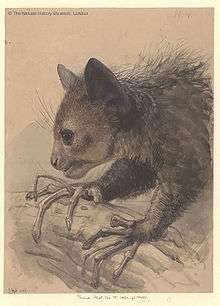
.jpg)
The aye-aye is a nocturnal and arboreal animal meaning that it spends most of its life high in the trees. Although they are known to come down to the ground on occasion, aye-ayes sleep, eat, travel and mate in the trees and are most commonly found close to the canopy where there is plenty of cover from the dense foliage. During the day, aye-ayes sleep in spherical nests in the forks of tree branches that are constructed out of leaves, branches and vines before emerging after dark to begin their hunt for food. Aye-aye are solitary animals that mark their large home range with scent. The smaller territories of females often overlap those of at least a couple of males. Male aye-ayes tend to share their territories with other males and are even known to share the same nests (although not at the same time), and can seemingly tolerate each other until they hear the call of a female that is looking for a mate.
Diet and foraging
The aye-aye is an omnivore and commonly eats seeds, fruits, nectar and fungi, but also insect larvae and honey.[33] Aye-ayes tap on the trunks and branches of trees at a rate of up to eight times per second, and listen to the echo produced to find hollow chambers. Studies have suggested that the acoustic properties associated with the foraging cavity have no effect on excavation behavior.[6] Once a chamber is found, they chew a hole into the wood and get grubs out of that hole with their highly adapted narrow and bony middle fingers.[34] The aye-aye begins foraging between 30 minutes before and three hours after sunset. Up to 80% of the night is spent foraging in the canopy, separated by occasional rest periods. It climbs trees by making successive vertical leaps, much like a squirrel. Horizontal movement is more difficult, but the aye-aye rarely descends to jump to another tree, and can often travel up to 4 km (2.5 mi) a night.[35][36]
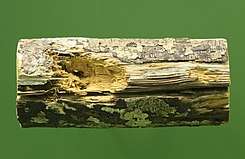
Though foraging is usually solitary, they occasionally forage in groups. Individual movements within the group are coordinated using both vocalisations and scent signals.[37]
Social systems
The aye-aye is classically considered 'solitary' as they have not been observed to groom each other. However, recent research suggests that it is more social than once thought. It usually sticks to foraging in its own personal home range, or territory. The home ranges of males often overlap, and the males can be very social with each other. Female home ranges never overlap, though a male's home range often overlaps that of several females. The male aye-ayes live in large areas up to 80 acres (320,000 m2), while females have smaller living spaces that goes up to 20 acres (81,000 m2). It is difficult for the males to defend a singular female because of the large home range. They are seen exhibiting polygyny because of this.[38] Regular scent marking with their cheeks and neck is how aye-ayes let others know of their presence and repel intruders from their territory.[39]
Like many other prosimians, the female aye-aye is dominant to the male. They are not typically monogamous, and will often challenge each other for mates. Male aye-ayes are very assertive in this way, and sometimes even pull other males away from a female during mating. Males are normally locked to females during mating in sessions that may last up to an hour. Outside of mating, males and females interact only occasionally, usually while foraging.[35] The aye-aye is thought to be the only primate which uses echolocation to find its prey.[40]
Distribution and habitat

The aye-aye lives primarily on the east coast of Madagascar. Its natural habitat is rainforest or deciduous forest, but many live in cultivated areas due to deforestation. Rainforest aye-ayes, the most common, dwell in canopy areas, and are usually sighted above 70 meters altitude. They sleep during the day in nests built from interwoven twigs and dead leaves up in the canopy among the vines and branches.[35]
Conservation
The aye-aye was thought to be extinct in 1933, but was rediscovered in 1957. Nine individuals were transported to Nosy Mangabe, an island near Maroantsetra off eastern Madagascar, in 1966.[41] Recent research shows the aye-aye is more widespread than was previously thought, but its conservation status was changed to Endangered in 2014.[1][2] This is for three main reasons: the aye-aye is considered evil, the forests of Madagascar are being destroyed, and the farmers will kill aye-ayes to protect their crops and for poaching. However, there is no direct evidence to suggest aye-ayes pose any legitimate threat to crops and therefore are killed based on superstition.[42]
As many as 50 aye-ayes can be found in zoological facilities worldwide.[43]
Folk belief
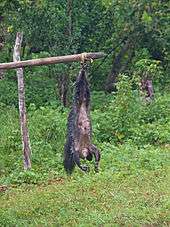
The aye-aye is often viewed as a harbinger of evil and killed on sight. Others believe, if one points its narrowest finger at someone, they are marked for death. Some say that the appearance of an aye-aye in a village predicts the death of a villager, and the only way to prevent this is to kill it. The Sakalava people go so far as to claim aye-ayes sneak into houses through the thatched roofs and murder the sleeping occupants by using their middle finger to puncture the victim's aorta.[9]
Captive breeding
The conservation of this species has been aided by captive breeding, primarily at the Duke Lemur Center in Durham, North Carolina. This center has been influential in keeping, researching and breeding aye-ayes and other lemurs. They have sent multiple teams to capture lemurs in Madagascar and have since created captive breeding groups for their lemurs. Specifically, they were responsible for the first aye-aye born into captivity and studied how he and the other aye-aye infants born at the center develop through infancy. They have also revolutionized the understanding of the aye-aye diet.[34]
References
- Louis, E.E., Sefczek, T.M., Randimbiharinirina, D.R., Raharivololona, B., Rakotondrazandry, J.N., Manjary, D., Aylward, M. & Ravelomandrato, F. (2020). "Daubentonia madagascariensis". IUCN Red List of Threatened Species. 2020: e.T6302A115560793. Retrieved 18 July 2020.CS1 maint: uses authors parameter (link) CS1 maint: ref=harv (link)
- "Checklist of CITES Species". CITES. UNEP-WCMC. Retrieved 18 March 2015.
- Gray, J. E. (1863). "Revision of the Species of Lemuroid Animals, with the Description of some New Species". Proceedings of the Zoological Society of London. 31: 151. doi:10.1111/j.1469-7998.1863.tb00390.x.
- Petter, J; Albignac, R; Rumpler, Y (1977). "Primates Prosimiens". ORSTOM.
- "Aye-Aye Daubentonia madagascariensis". National Geographic. Retrieved 18 May 2010.
- Erickson, C.J.; Nowicki, S.; Dollar, L.; Goehring, N. (1998). "Percussive Foraging:stimuli for prey location by aye-ayes (Daubentonia madagascariensis)". International Journal of Primatology. 19 (1): 111. doi:10.1023/A:1020363128240. S2CID 27737088.
- Sterling, E. J.; McCreless, E. E. (2006). "Adaptations in the ayeaye: A review". Lemurs: Ecology and Adaptations. Gould L, Sauther ML.
- Sterling 2003, p. 1348.
- Piper, Ross (2007). Extraordinary Animals: An Encyclopedia of Curious and Unusual Animals. Greenwood Press. ISBN 9780313339226.
aye-aye.
- Beck 2009, p. ??.
- Nowak 1999, pp. 533–534.
- Dunkel, A.R.; Zijlstra, J.S.; Groves, C.P. (2011–2012). "Giant rabbits, marmosets, and British comedies: etymology of lemur names, part 1" (PDF). Lemur News. 16: 64–70. ISSN 1608-1439. Archived from the original (PDF) on 2016-11-06. Retrieved 2014-10-17.
- Groves 2005.
- Ankel-Simons 2007, p. 257.
- "The Aye-Ayes or Cheiromys of Madagascar". Science. 2 (75): 574–576. 3 November 1881. doi:10.1126/science.os-2.76.574. PMID 17791380.
- Yoder, Vilgalys & Ruvolo 1996, pp. ??.
- Groves 2005, p. 121.
- Del Pero, M.; Crovella, S.; Cervella, P.; Ardito, G.; Rumpler, Y. (1995). "Phylogenetic relationships among Malagasy lemurs as revealed by mitochondrial DNA sequence analysis". Primates. 36 (3): 431–440. doi:10.1007/BF02382865. S2CID 25558426.
- Porter, C.A.; Sampaio, I.; Schneider, H.; Schneider, M.P.C.; Czelusniak, J.; Goodman, M. (1995). "Evidence on primate phylogeny from ε-globin gene sequences and flanking regions". Journal of Molecular Evolution. 40 (1): 30–55. Bibcode:1995JMolE..40...30P. doi:10.1007/BF00166594. PMID 7714911. S2CID 9509799.
- Yoder, A.D.; Vilgalys, R.; Ruvolo, M. (1996). "Molecular evolutionary dynamics of cytochrome b in strepsirrhine primates: the phylogenetic significance of third-position transversions". Molecular Biology and Evolution. 13 (10): 1339–1350. doi:10.1093/oxfordjournals.molbev.a025580. PMID 8952078.
- Roos, C.; Schmitz, J.; Zischler, H. (2004). "Primate jumping genes elucidate strepsirrhine phylogeny". Proceedings of the National Academy of Sciences. 101 (29): 10650–10654. Bibcode:2004PNAS..10110650R. doi:10.1073/pnas.0403852101. PMC 489989. PMID 15249661.
- Horvath, J.E.; Weisrock, D.W.; Embry, S.L.; Fiorentino, I.; Balhoff, J.P.; Kappeler, P.; Wray, G.A.; Willard, H.F.; Yoder, A.D. (2008). "Development and application of a phylogenomic toolkit: Resolving the evolutionary history of Madagascar's lemurs". Genome Research. 18 (3): 489–499. doi:10.1101/gr.7265208. PMC 2259113. PMID 18245770.
- Orlando, L.; Calvignac, S.; Schnebelen, C.; Douady, C.J.; Godfrey, L.R.; Hänni, C. (2008). "DNA from extinct giant lemurs links archaeolemurids to extant indriids". BMC Evolutionary Biology. 8 (121): 121. doi:10.1186/1471-2148-8-121. PMC 2386821. PMID 18442367.
- Brosius, J.; Perelman, P.; Johnson, W.E.; Roos, C.; Seuánez, H.N.; Horvath, J.E.; Moreira, M.A.M.; Kessing, B.; Pontius, J.; Roelke, M.; Rumpler, Y.; Schneider, M.P.C.; Silva, A.; O'Brien, S.J.; Pecon-Slattery, J. (2011). "A Molecular Phylogeny of Living Primates". PLOS Genetics. 7 (3): e1001342. doi:10.1371/journal.pgen.1001342. PMC 3060065. PMID 21436896.
- Perry, G.H.; Reeves, D.; Melsted, P.; Ratan, A.; Miller, W.; Michelini, K.; Louis, E.E.; Pritchard, J.K.; Mason, C.E.; Gilad, Y. (2012). "A Genome Sequence Resource for the Aye-Aye (Daubentonia madagascariensis), a Nocturnal Lemur from Madagascar". Genome Biology and Evolution. 4 (2): 126–135. doi:10.1093/gbe/evr132. PMC 3273163. PMID 22155688.
- Sellers, Bill (2000-10-20). "Primate Evolution" (PDF). University of Edinburgh. pp. 13–17. Archived from the original (PDF) on 2009-02-25. Retrieved 2008-10-23.
- Ali, J. R.; Huber, M. (2010-01-20). "Mammalian biodiversity on Madagascar controlled by ocean currents". Nature. 463 (4 Feb. 2010): 653–656. Bibcode:2010Natur.463..653A. doi:10.1038/nature08706. PMID 20090678. S2CID 4333977.
- Gunnell, G.F.; Boyer, D.M.; Friscia, A.R.; Heritage, S.; Manthi, F.K.; Miller, E.R.; Sallam, H.M.; Simmons, N.B.; Stevens, N.J.; Seiffert, E.R. (2018). "Fossil lemurs from Egypt and Kenya suggest an African origin for Madagascar's aye-aye". Nature Communications. 9 (1): 3193. Bibcode:2018NatCo...9.3193G. doi:10.1038/s41467-018-05648-w. PMC 6104046. PMID 30131571.
- Mittermeier et al. 2008, pp. ??.
- "Aye-Aye". National Geographic. Retrieved 10 April 2019.
- Soligo, C. (2005). "Anatomy of the hand and arm in Daubentonia madagascariensis: a functional and phylogenetic outlook". Folia Primatol. 76 (5): 262–300. doi:10.1159/000088034. PMID 16230860. S2CID 25535277.
- Hartstone‐Rose, A.; Dickinson, E.; Boettcher, M. L.; Herrel, A. (2020). "A primate with a panda's thumb: The anatomy of the pseudothumb of Daubentonia madagascariensis". American Journal of Physical Anthropology. 171 (1): 8–16. doi:10.1002/ajpa.23936. PMID 31633197.
- Mittermeier et al. 2010, p. 606.
- Haring, David (March 1996). "Eep! It's an Aye-Aye". Wildlife Conservation: 28–35.
- Garbutt, N. (1999). Mammals of Madagascar. New Haven: Yale University Press. ISBN 0-300-07751-3. OCLC 41158604.
- The Dodo: Journal of Durrell Wildlife Conservation Trust Volume 30. Jersey, Channel Islands: Jersey Wildlife Preservation Trust. 1994. p. 43. ISBN 0-9515581-7-X.
- "Primate Factsheets: Aye-aye (Daubentonia madagascariensis) Behavior". pin.primate.wisc.edu. Retrieved 2019-12-02.
- Sterling, Eleanor (1993). Kappeler (ed.). "Patterns of Range Use and Social Organization in Aye-ayes (Daubentonia madagascariensis) on Nosy Mangabe". Lemur Social Systems and Their Ecological Basis. Plenum Press, New York: 1–10. doi:10.1007/978-1-4899-2412-4_1. ISBN 978-1-4899-2414-8.
- "Aye-Aye". Durrell Wildlife Conservation Trust. 2006-10-26. Retrieved 2011-12-21.
- "Aye-Aye". National Geographic Society. Retrieved 7 March 2012.
- Mittermeier et al. 2010, pp. 605–606.
- Hill, Catherine M. (December 2002). "Primate Conservation and Local Communities-Ethical Issues and Debates". American Anthropologist. 104 (4): 1184–1194. doi:10.1525/aa.2002.104.4.1184.
- Mittermeier et al. 2010, p. 609.
External links
| Wikimedia Commons has media related to Daubentonia madagascariensis. |
| Wikispecies has information related to Daubentonia madagascariensis |
| Look up aye-aye in Wiktionary, the free dictionary. |
Literature cited
- Ankel-Simons, F. (2007). Primate Anatomy (3rd ed.). Academic Press. ISBN 978-0-12-372576-9.CS1 maint: ref=harv (link)
- Beck, R. M. D. (2009). "Was the Oligo-Miocene Australian metatherian Yalkaparidon a 'mammalian woodpecker'?". Biological Journal of the Linnean Society. 97 (1): 1–17. doi:10.1111/j.1095-8312.2009.01171.x.CS1 maint: ref=harv (link)
- Groves, C. P. (2005). "Order Primates". In Wilson, D. E.; Reeder, D. M (eds.). Mammal Species of the World: A Taxonomic and Geographic Reference (3rd ed.). Johns Hopkins University Press. pp. 111–184. ISBN 978-0-8018-8221-0. OCLC 62265494.
- Mittermeier, R.A.; Louis, E.E.; Richardson, M.; Schwitzer, C.; et al. (2010). Lemurs of Madagascar. Illustrated by S.D. Nash (3rd ed.). Conservation International. ISBN 978-1-934151-23-5. OCLC 670545286.
- Mittermeier, R. A.; Ganzhorn, J. U.; Konstant, W. R.; Glander, K.; Tattersall, I.; Groves, C. P.; Rylands, A. B.; Hapke, A.; Ratsimbazafy, J.; Mayor, M. I.; Louis, E. E.; Rumpler, Y.; Schwitzer, C.; Rasoloarison, R. M. (2008). "Lemur Diversity in Madagascar" (PDF). International Journal of Primatology. 29 (6): 1607–1656. doi:10.1007/s10764-008-9317-y. hdl:10161/6237. S2CID 17614597. Archived from the original (PDF) on 2018-08-27. Retrieved 2015-09-01.CS1 maint: ref=harv (link)
- Nowak, R.M. (1999). Walker's Primates of the World (6th ed.). Baltimore, Maryland: Johns Hopkins University Press. ISBN 978-0-8018-6251-9.CS1 maint: ref=harv (link)
- Sterling, E. (2003). "Daubentonia madagascariensis, Aye-aye, Aye-aye". In Goodman, S.M.; Benstead, J.P. (eds.). The Natural History of Madagascar. University of Chicago Press. pp. 1348–1351. ISBN 978-0-226-30306-2.CS1 maint: ref=harv (link)
- Yoder, A. D.; Vilgalys, R.; Ruvolo, M. (1996). "Molecular evolutionary dynamics of cytochrome b in strepsirrhine primates: The phylogenetic significance of third-position transversions" (PDF). Molecular Biology and Evolution. 13 (10): 1339–1350. doi:10.1093/oxfordjournals.molbev.a025580. PMID 8952078.CS1 maint: ref=harv (link)
